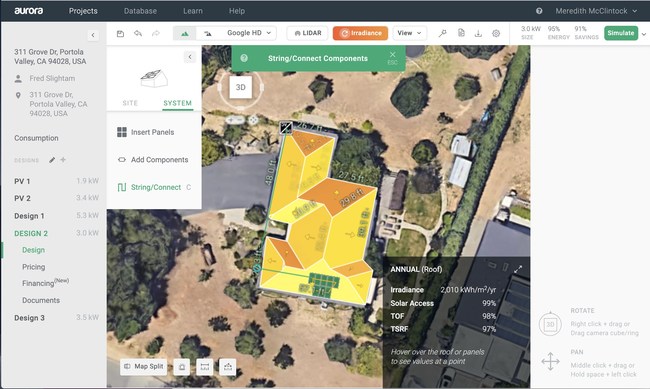New housing in California (up to three stories) has to have enough solar to meet the building’s estimated annual electricity needs, as per the new solar mandate in the California building code.
The mandate “presents new challenges for the homebuilding industry — especially designing PV systems for buildings and measuring solar access for roofs that haven’t been constructed yet,” said Meredith McClintock, head of business development at Aurora.
Aurora Solar was the first to receive the California Energy Commission’s certification as an approved tool to assess solar irradiance on new home construction. Aurora’s software allows “solar installers and builders…to quickly and correctly size PV systems, and export reports that can be submitted to the CEC.”
Sunny Wang, Aurora’s director of government affairs and communications, noted that the mandate means that “solar has to be moved up in front of the design process. You have to plan for a PV system before you start building.” Aurora can model the site from an uploaded blueprint.
Aurora can generate an irradiance map showing the solar irradiance at every point of the roof.

Aurora also assembled a guide to help homebuilders navigate the solar mandate certification process. The guide details the documentation needed for compliance. Aurora claims to have designed over 2.5 million projects with its software.
The change in the building code could add more than 1 GW of PV over the next five years, according to analysts.
Exceptions to the rule
According to the California Energy Commission (CEC), “Exceptions to the PV requirement exist for specific instances in which a house may be built in an area of insufficient solar availability [shade] or where electricity rates are uncommonly low.” Buildings with especially small rooftops will be exempt.
Home builders can reduce the size of the solar installation by implementing grid-friendly battery storage, energy efficiency, and demand-response measures.
Removing the teeth from the mandate
Last month, the CEC weakened some of the regulatory strength of the California Solar Mandate when it approved Sacramento Municipal Utility District’s Neighborhood SolarShares Program, a proposal for community solar under the 2019 Building Energy Efficiency Standards.
The CEC decided to give Sacramento home builders and homeowners the choice of purchasing solar power from SMUD’s community solar program — instead of following the mandate of putting solar systems on all new homes. The revised language sets a precedent in the way that the California solar mandate will be enacted and how the mandate will be approached by home developers and the state’s other utilities.
This content is protected by copyright and may not be reused. If you want to cooperate with us and would like to reuse some of our content, please contact: editors@pv-magazine.com.








By submitting this form you agree to pv magazine using your data for the purposes of publishing your comment.
Your personal data will only be disclosed or otherwise transmitted to third parties for the purposes of spam filtering or if this is necessary for technical maintenance of the website. Any other transfer to third parties will not take place unless this is justified on the basis of applicable data protection regulations or if pv magazine is legally obliged to do so.
You may revoke this consent at any time with effect for the future, in which case your personal data will be deleted immediately. Otherwise, your data will be deleted if pv magazine has processed your request or the purpose of data storage is fulfilled.
Further information on data privacy can be found in our Data Protection Policy.